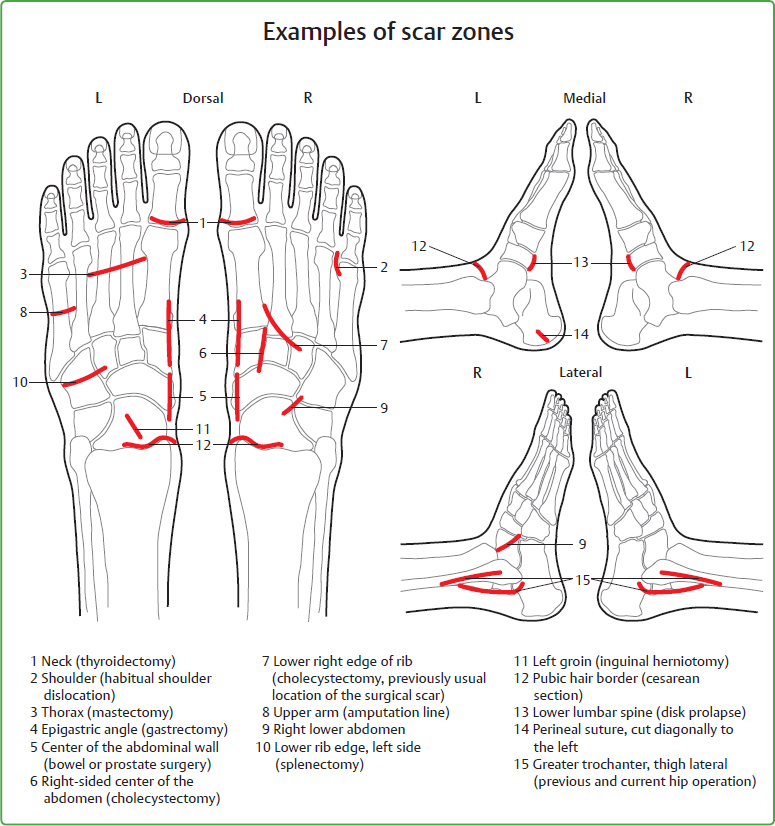25 Treatment of Scars with Reflexotherapy of the Feet Almost everyone has scars, but many injuries and wounds heal naturally, leaving no particularly disturbing impressions at either a physical or emotional level. Nevertheless, time and again we find that sooner or later scars may become interference fields in relation to various functions in a person. In these cases they may, for example, adhere to the surrounding tissue so tightly that they cause congestion, local circulatory disturbances, and restriction of movement. In acupuncture it is also known that scars inhibit the flow of energy in the affected meridians. As more people nowadays are open to connections of this kind and themselves notice that scars can impair health, a series of effective methods has been developed, for example: • Connective tissue massage • Traditional scar massage • Neural therapy • Manual lymphatic drainage • Various meridian therapies • Light, color, and gemstone therapy, etc. The method used depends upon the therapist’s professional background and the special disposition of the patient. However, we should consider the possibility of the “interference field scar” during the first assessment and ask specific questions in that direction. When questioned, patients do not always remember their scars spontaneously. It is therefore advisable to briefly mention the most common events resulting in scars: Operations, dog bites, cycling accidents, barbed wire, kitchen knives, pieces of broken glass, war injuries, stones being thrown, perineal sutures, vaccination scars, work or sports accidents, boil excision, injuries from spades or lawnmowers, burns, road traffic accidents, etc. With a weakened constitution and troublesome current disposition, scars from piercings can also become interference fields. Any scar may develop into an interference field sooner or later, regardless of whether it is fresh or old, large or small, painful or not. An “interference field scar” can be recognized by the following means: • The development of complaints which did not exist previously and which coincide with the appearance of the scar, whether far from the scar, in its immediate vicinity, or in the surrounding area • Energetic measurements of the tissue tension of the scar and its surrounding area • Spontaneous description of unpleasant or painful sensations in the region of the scar • Noticeable emotional reactions if the patient is asked about the scar or if it is touched • Reactions in the zone to which the scar is assigned. This can manifest itself as • pain in the zone of the scar, • symptoms of autonomic irritation during treatment of the zone, and/or • unexpected emotions triggered by treatment of the zone corresponding to the scar in situ. Memories of how the scar was acquired are frequently evoked as a result. If treatment of the scar zone does not trigger any physical or emotional reactions at the time or before the next treatment session, we can safely presume that the scar does not constitute an interference field. Above all, larger scars on the head, neck, and trunk are suitable for zone treatment. Scars on the extremities can be treated as far as the region of the elbow and knee. However, collateral and/or contralateral therapy lends itself on the extremities (Chapter 18.4), especially on the lower legs and feet and lower arms and hands. Small scars are usually treated more effectively with other methods, for example, neural therapy, etc. Important note: It should be pointed out to the patient that not only physical but also emotional blocks may be released during scar treatment and that they can and should express the thoughts and feelings arising as a result. Experience shows that zones of scars are usually found in the dorsal part of the feet as most incisions during an operation are performed ventrally in the thorax and abdomen. Locating the zone of the scar is easiest when applying the guiding principle of the method: a seated person corresponds in shape to the feet. Therefore, scar zones of the • head and neck are found in the region of the toes, • thorax and upper abdomen on the metatarsal bones, • abdomen and pelvis on the tarsal bones, and • thigh and knee in the distal part of the lower legs.
25.1 General Information
25.2 Performance
25.2.1 Choice of Scars for Reflexotherapy of the feet
25.2.2 Localization of Scar Zones
Musculoskeletal Key
Fastest Musculoskeletal Insight Engine








